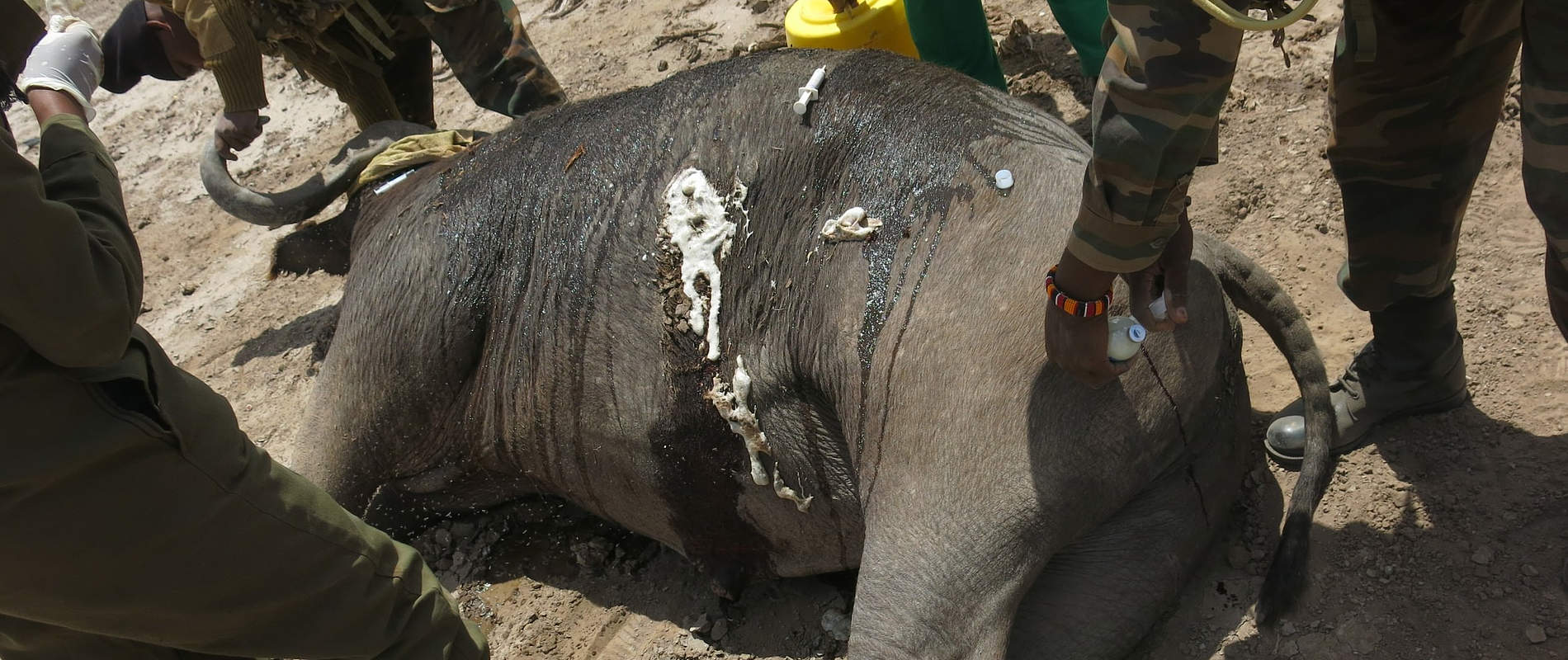Introduction The month of August has been characterized by the exodus of wild animals particularly elephants from the swamps to wander in conservancies where they can get variable trees and shrubs to browse on
Introduction
The month of August has been characterized by the exodus of wild animals particularly elephants from the swamps to wander in conservancies where they can get variable trees and shrubs to browse on. Thus, their numbers in the park is dwindling day by day. Other medium and small grazers have been seen to concentrate within the wet and swampy areas for what appears to be their delicacy at this particular hard time. Climate has been extremely dry with alternate hot and cold moments surmounted by frequent strong dusty winds. The park seems to be the quenching point for domestic animals as the ecosystem boils in strong sun and dry cold winds.
During the month human-wildlife conflict signs were noticeable. This varied from spear injuries to predation. Other cases included the capture and translocation of an orphan in Tsavo East and alsoa snake which had caused panic and fear among the herders at Satao Elerai.
Following are veterinary activities attended to during the month;
1. INJURED LION
Date: 02/08/2017
Species: Lion
Sex: Male
Age: Adult
Location: Tsavo East National Park
History
The Amboseli Mobile Vet Unit was informed of an injured lion at Gutuni Lodge by DSWT chopper pilot Mr. Payne on 1/8/2017. The injury was attributed by being tossedby a buffalo following an unsuccessful hunting mission. It was late in the afternoon thus an arrangement was made for the vet to be picked by DSWT fixed wing on Sky Vet Initiative early on 2/8/2017 from Amboseli Park Headquarters Airstrip. This mission was also planned to accommodate another case of an injured male elephant which had been spotted earlier on previous day at Satao Lodge.
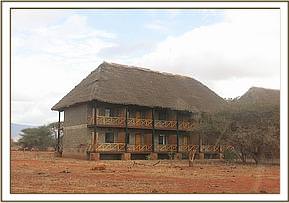

Immobilization
It was darted using 375mgs Ketamine mixed with 4mgs Medetomidine. It was fully immobilized in six minutes. It was approached carefully and pinched on the right hind toes to establish how deep the sedation was. It was good enough to allow manipulation during examination.
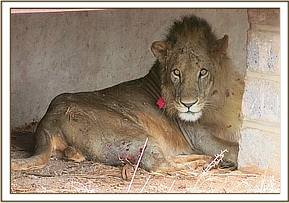

Examination
Clearly visible were numerous skin puncture wounds of varying sizes with a seemingly extensive open wound on left hind limb at genu joint posteriorly. Other wounds were situated on gluteal muscles and all were discharging foul smelly straw discharges.
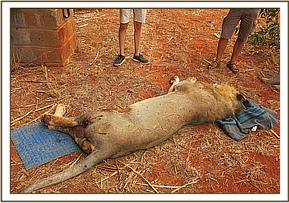

Diagnosis and discussion
The lion had been injured severely during the hunting mission by buffalo horn which completely disintegrated the joint components. This further increased the vulnerability of the lion to the territorial fights because of the incapacitation.
Prognosis and Conclusion
Due to poor prognosis, a decision to put it down was made in order to alleviate further suffering considering the nature of injuries sustained. It was humanely put down and handed over to Tsavo East National Park administration to harness the trophies and onward transmission.


2. ELEPHANT TREATMENT
Date: 02/08/2017
Species: Elephant
Sex: Male
Age: Adult
Location: Tsavo East National Park
History
This was the second case after the lion case above. It was attended through Sky Vet Initiative. The elephant was found accompanied by three other males and was resting under tree shade near dry river bed.
Immobilization
Immobilization was attained by use of three centiliter dart which contained 18mgsEtorphine topped up with water for injection. It was approached using vehicle. The left ear was used to cover the left eye from direct sun light and the distal end of trunk was kept open by use of a piece of stick put across the nares.


Examination
The discharging wound on the mid left abdominal area had a canal leading rostrodorsal about fifteen centimeters deep and a dead space of about half a litre filled with tenacious gray pus. This was established after probing using long forceps to establish whether there was any foreign body. This was a clear arrow wound and was more than two weeks old. It was just under the skin thus little damage to underneath abdominal muscles


Treatment
The pouch was drained by pressing followed by thorough cleaning using Hydrogen Peroxide and rinsed with Tincture of Iodine. Cloxacillin5mgs antibiotic cream was infiltrated into the canal followed by generous packing of green wet clay into the pouch to encourage tissue regeneration. It was covered systemically with 15000mgs Amoxicillin into gluteal muscles. Dart wound was infiltrated with 5gms of Cloxacilin antibiotic cream to cater for any sepsis and right eye to prevent damage.
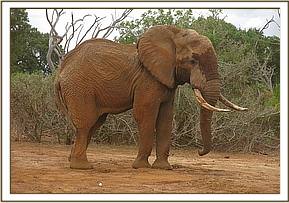

Prognosis
This was projected as good because the injury was sub-dermal and was effectively drained and cleaned.
3. ELEPHANT TREATMENT
Date: 03/08/2017
Species: Elephant
Sex: Male
Age: Adult
Location: Kimana Sanctuary
History
The Amboseli Mobile Vet Unit was notified of an injured elephant by the sanctuary rangers who encountered it while on normal patrol. It was reported as having a bloody discharge from the injury on the left side of left hind limb. We quickly set out on a mission to intervene.
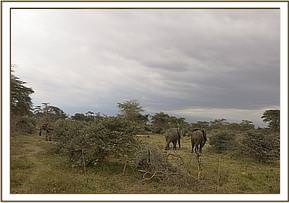

Immobilization
It was found in company of several bulls among whom was Tim. It was darted using 15mgsEtorphine and 1000 I.U Hyaluronidase. After eight minutes it fell down on right recumbence but quickly got up and remained static resisting to lie down by spreading its limbs apart to increase stability. On the tenth minute three milligrams of Etorphine were injected into thigh muscle by hand. It assumed sternal recumbences after two minutes. It was pushed to right lateral recumbence by use of rope passing on the left head side and being pulled by eight men.

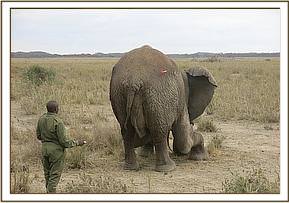

Examination
The injury appeared to have been caused by spear on the left ischium area. The discharge was both mixture of flank blood and gray thick pus. It depicted an old wound but with fresh irritation thus bloody discharge. This was probed for foreign body and depth. No foreign body was discovered and depth was about thirteen centimeters deep near the bony prominence.
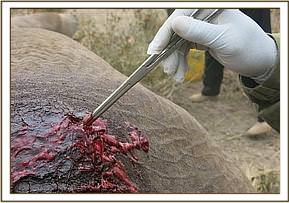
Treatment
Both wounds were thoroughly drained by pressing out the pus, followed by plenty of Hydrogen Peroxide and Tincture of Iodine. Each was infiltrated with 3000mgs Amoxicillin followed by liberal packing of green clay to enhance healing. Antibiosis was achieved by use of 24000mgs Amoxicillin into different muscle sites, 100mgs Dexamethasone slowly into ear vein and 50ml of Cyanocobalamin as metabolic stimulant.
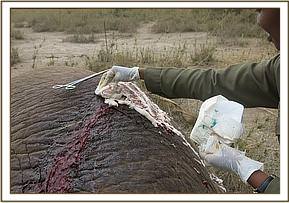
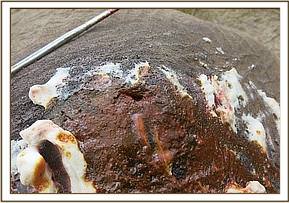

Prognosis
This was placed as fair and will be revised after review which will be between tenth and fifteenth day if sighted.
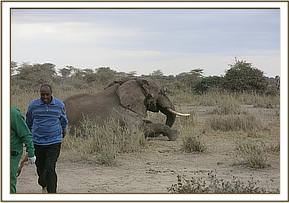

4. ELEPHANT CAPTURE
Date: 05/08/2017
Sex: Male
Age: Juvenile
Location: Tsavo East National Park
History and plan
A call was received on 3/08/2017 concerning three elephant orphans which had strayed far off from Ithumba stockade about two months earlier. This was as a result ofthe older orphan having led the others away failing to return from the usual days browse. The orphans were monitored as from 3rd to 5th when an opportunity for capture of the weakest looking of the orphans was possible. Everything from equipment and personnel was assembled from Kaluku to an open savannah so as to embark on the exercise. The aim was to capture the orphan using sedatives, load it into suitable carrier vehicle and translocate it back to Ithumba.
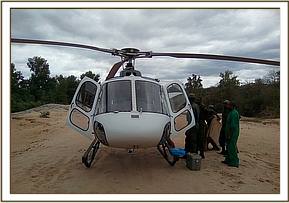

Immobilization
It was darted using 5mgsEtorphine and 1000 I.U Hyaluronidase after forcing them near to the road by chopper where the ground team was. It was down on left recumbence in five minutes and the older counterpart kept guard by the side. The darted orphan was secured ready for loading into the waiting open land cruiser pick-up. Meanwhile the vet was dropped by chopper at an appropriate location where he was picked up by a vehicle and taken to the loading site to coordinate the exercise.
Loading and Journey
Vital parameters were being monitored every ten minutes to ensure the orphan was well. It was loaded into the land cruiser. The vet in company with rangers and keepers kept a keen watch and monitoring during the more than two hours long and dusty journey. The orphan was placed on left lateral recumbence in a stockade and the limbs were unsecured ready to reverse the narcosis. It was up strongly in one minute and staggered in attempt to orient itself. Keepers armed with milk replacer called out its name and immediately rewarded it with a bottle of replacer which it drunk quickly. It went for pellets grabbing them by its trunk and putting them into mouth chewing as it inspected the boma. Attendants and other keepers were instructed to move back and left two to avoid unnecessary stress. It calmed down and water was dowsed on its body.It had to be monitored closely over night and on the following morning it was visited and found to have settled into the boma completely.
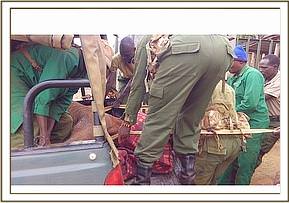

The oldest orphan was monitored to ascertain whether capture was necessary. But it was expected to acclimatize and be accommodated well by wild counterparts as it already had more experience in the wild before its rescue. The third orphan returned to the stockade approximately 2 weeks later in good condition.
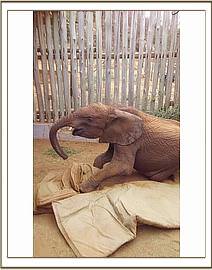

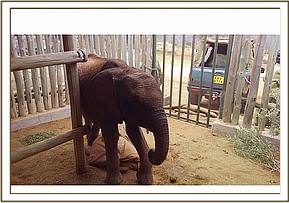

Prognosis
Good because it had settled well with no accompanying complication.
5. PYTHON CAPTURE
Date: 15/08/2017
Species: Rock Python
Sex: Female
Age: Juvenile
Location: Satao Elerai Community Conservancy
History
Amboseli Mobile Vet Unit was informed of an engorged python within the conservancy by Amboseli National Park Camp Sargent. It was alluded that the herders who are Maasai wanted to kill it alleging that it had swallowed one of their young goats. Immediately we set out to rescue the reptile.
Immobilization and Capture
The reptile was found under shelter of a thorny shrub where it had taken refuge following the eminent threat. The residents had hauled pieces of dry sticks/woods and stones onto it in attempt to revenge. The thicket was severed using a machete in order to expose it to initiate capture. This exposed the tail and after drugging it out of the thicket, head was immobilized using a ‘Y’ stick just behind its’ mandible. Hand was used to grab its neck and the other hand used to lift its’ tail. It was secured in a nylon sac safely for transport and release away from people habited area.


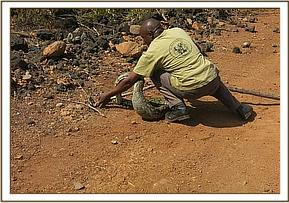

Release
The serpent was released in Tsavo West National Park on 17/08/2017 while on another mission involving an injured Maasai giraffe calf. The sac was untied and the serpent let off the sac. Several samples were taken including whole blood and buccal swabs for future use. It was approximated to be about fifteen kilograms.

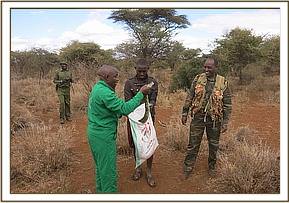
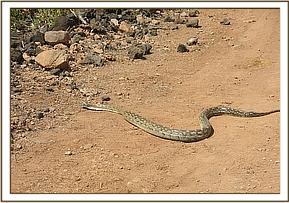

6. INJURED GIRAFFE
Date: 17/08/2017
Species: Maasai Giraffe
Sex: Female
Age: Calf
Location: Tsavo West National Park
History
The report of an injured young giraffe at Finch Hatton Lodge in Tsavo West National Park was on the evening of 16/08/2017
Immobilization
The giraffe had been spotted the previous evening being unable to walk even after being lifted from the ground and had wounds on the head. It was found lying down on a rocky area with its breathing shallow and rapid. It was not strong enough to put up any defense on examination.
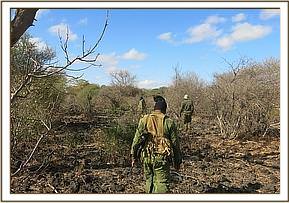

Examination
It was observed that it was barely a week old. The left ossicle was missing and on its’ location leaving dry cranial frontal bone. The left ear was mutilated and heavily infested with maggots. The head was held tilted to the left side. Attempt to lift it up to stand on its own was positive but it kept on circling to the left side.


Prognosis and Conclusion
It was concluded as having a poor prognosis. This was informed by the obvious injury to the brain as depicted by circling. It was observed that the injuries on cranium could have been precipitated by a blow on the head having fallen over considering the rocky terrain. This blow is thought to have caused incapacitation hence the calf could not recover giving hyenas a chance to chew off the ossicles and mutilate the ear. The ear was invaded by traumatic Myiasis. To alleviate further pain the calf was euthanized and post mortem done.
Postmortem Findings
It was established that the traumatic myiasis had not reached the inner ear and that the brain had no cerebral spinal fluid and a blood clot was recovered instead. It had two punctures on the cortex corresponding to the two externally observed fenestrae. The brain had necrotized massively under the cortex on areas adjacent to the blood clot and underneath up to brain stem. Prognosis was irreversible brain damage
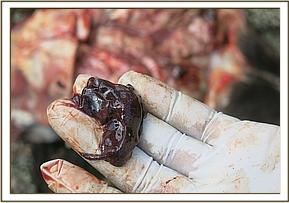
7. SEARCH FOR INJURED ELEPHANT
Date: 19/08/2017
Species: Elephant
Sex: Male
Age: Adult
Location: Chyulu Hills National Park
History
The report of a speared elephant was made to the Amboseli Mobile Vet Unit in the evening of 18/08/2017 by DSWT Chopper pilot. The vet was required on the following day to travel to Kiboko so that a timely intervention could be effected once the elephant was spotted. The search parties were Big Life Foundation Rangers from Sultan area where the elephant was suspected to have been speared, the Kibwezi DSWT De-snaring Unit and DSWT fixed wing from Kaluku DSWT Airfield.
On the morning of 19thtwo groups of families were spotted by help of the fixed wing and a verification done by ground team on foot because of rough unmotorable terrain all in vain.The exercise was rescheduled for the following day. The vet remained on standby. On the following day the 20/08/2017 the vet was informed by Big Life Foundation that a similar injured elephant had been spotted around OldonyoWuas Lodge but quickly went into thick bushes. By 22/08/2017 the said elephant had not resurfaced and the Vet Unit remains on high alert if by any chance positive the elephant emerges.
8. INJURED LION
Date: 20/08/2017
Species: Lion
Sex: Male
Age: Adult
Location: Amboseli National Park
History
While the vet Unit was away on 19/08/2017 following up on a speared elephant at Kiboko, it was notified by Amboseli Community Warden of an injured lion at Amboseli National Park.
The search was mounted by the vet unit together with a patrol team in Amboseli. All possible locations were explored and searched extensively. It had been reported as showing territorial fight injuries. This could have been the case because during the search several mating couples were spotted and verified. All lions sighted on that particular day were all healthy enjoying breeding. Several tour drivers confirmed having spotted it the previous day but none confessed as having seen it on search day.
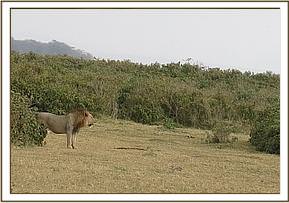

The Vet Unit will remain on high alert just in case the report is made so that an intervention can be done.
9. SPEARED BUFFALO
Date: 21/08/2017
Species: Buffalo
Sex: Male
Age: Adult
Location: Amboseli National Park
History
A report concerning a buffalo with a spear dangling from its left abdominal side was made to Amboseli Mobile Vet Unit by the Warden of Tourism while on park patrol. An intervention ensued immediately.
Immobilization
It was darted using 10mgsEtorphine and 180mgs Azaperone after waiting for it to be out of the swampy area. It was approached from behind and ascertained that it was fully immobilized when the blind fold was placed on its head.
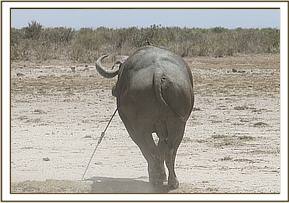

Examination and treatment
There was extensive sub cutis emphysema extending from the abdominal area all the way to neck base including the upper fore limbs. The spear had entered into the mid abdominal area on the left side about forty centimeters deep.
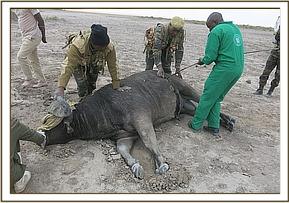

The wound was quickly cleaned with Hydrogen Peroxide and Tincture of Iodine. 5gms Of Cloxacillin ointment was infiltrated followed by generous parking of green clay into the resultant tunnel. It was covered systemically with 15000mgs Amoxicillin and 40mgs Dexamethasone into different muscle sites.
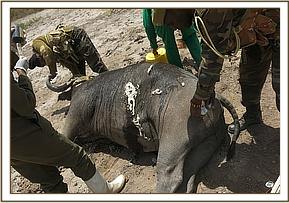

Reversal
It was quickly reversed with 80mgs Naltrexone into jugular vein and attempted to get up after three minutes. An effort to urge it up was in vain. After a deep inhalation stretching its neck and head up only to cease breathing totally.
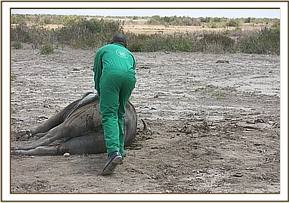

Postmortem
This ensued immediately. It was established that the spear penetrated into the rumen on the left side. Possibly the killer was aiming for the heart but missed. As the animal ambulated the spear kept puncturing more as depicted by three other holes on the dorsal part of the rumen.
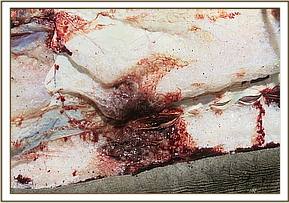

10. ELEPHANT TREATMENT
Date: 25/08/2017
Species: Elephant
Sex: Female
Age: Juvenile
Location: Amboseli National Park
History
On normal patrol duties within the park, the Amboseli Mobile Vet Unit bumped into an elephant family of seven members. We quickly noticed a discharge from one of the juvenile’s backs near the tail base. At close range we realized it was a spear wound about three days old. This called for an immediate intervention. We pulled away to pave way for dart preparation and prevent them from getting into the nearby swamp.
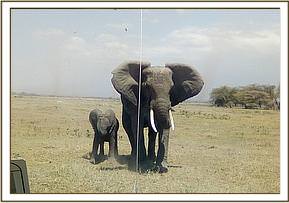

Immobilization
A dart was prepared composing of 5mgsEtorphine and 1000I.U Hyaluronidase topped up with water for injection. The counterparts didn’t react to the distraction and the candidate went down easily after five minutes. All others were scared away from the fallen candidate by use of vehicle
Examination
The spear injury was sub-dermal but about fifteen centimeters deep rostrolaterally to the right from the spine. Another cut on the distal tail was noted depicting that the spear caught the tail on the spine probably during action. No foreign object was recovered from the wound probe.
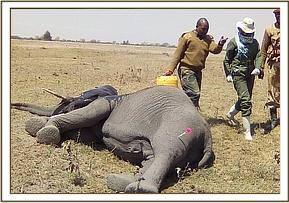

Treatment
Both injuries were cleaned thoroughly after probing with Hydrogen Peroxide and Iodine. This was followed with generous parking of wet green clay and sprayed with Tetracycline wound spray to repel the flies. Systemically the juvenile was covered with 7500mgs Tetracycline and 40mgs of Dexamethasone followed with 50ml of Cyanocobalamin as metabolic stimulant.
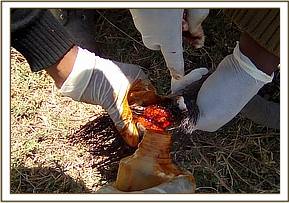

Prognosis
Good because the wound was treated while fresh with limited sepsis.


